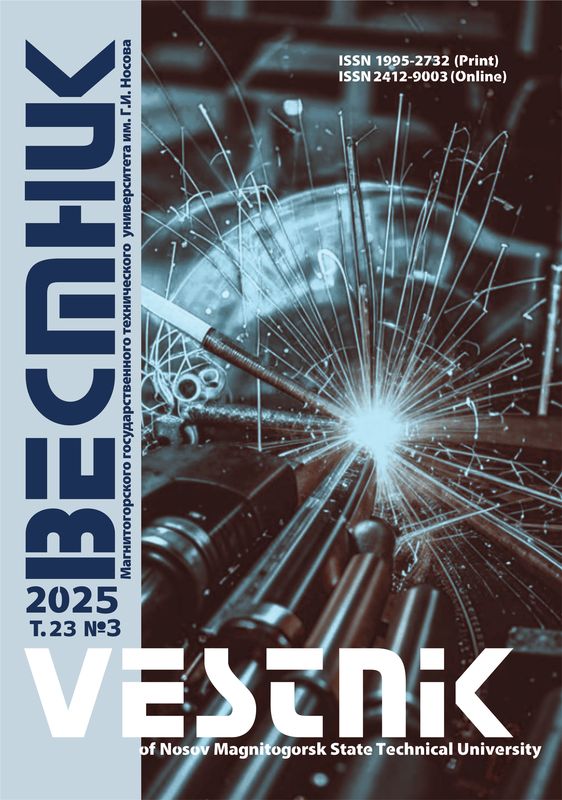Abstract
Problem Statement. When manufacturing high-strength steel strap on the production line of LLC Ural Metalworking Company, the strap camber defect may occur. It is known that the camber defect is caused by a difference in the tension of parallel strips of the strap in the performed technological operations. Methods Applied. In the areas between the roller tensioner and the furnace (before heat treatment) and after the water cooling bath (after heat treatment) on the production line of LLC Ural Metalworking Company, the strap camber value was measured, revealing an increased value of the defect. The statistical analysis of the defect value, with a large (⪖100) sample of measurements of crescent tape of two sizes, confirmed that an additional cause of the defect values, at high (⪖100) sampling of measured straps of two types and sizes, proved that an additional reason for strap camber was heat treatment by patenting in a lead bath. It is assumed that the camber is formed during the heat treatment as a result of the off-axis elastic-plastic strain of the strap. Off-axis strain is formed by friction forces acting on the strap edges, when the strap edges interact with the walls of the guide gauge roller immersed in the lead bath. As a result, there is an additional force factor - bending moment. The analysis of the stress-strain state of the strap at off-axis strain determines the scheme of force parameters affecting the strap camber during heat treatment. The stress-strain state of the strap in the elastic zone was calculated, which allowed us to establish the boundaries of plastic deformation zones. We found the dependence between the critical strap curvature and several parameters, namely strap width and thickness, strap tension and temperature. The criteria determining the beginning of plastic deformation along the strap edges of the tape were determined. It was found that by increasing tension, the strap camber may be reduced by 13–30%. Results. The statistical analysis established the influence of patenting operations on the strap camber. The scheme of force parameters was determined and the stress-strain state of the strap was calculated. The criteria determining the beginning of plastic deformation were determined and a possible significant decrease in camber was shown.
Keywords
High-carbon strap, camber, curvature, elastic and plastic deformation zones, friction on the strap edges.
1. Kunitsyn G.A. Povyshenie tochnosti protsessa kholodnoy prokatki lenty iz podkata klinovidnogo poperechnogo secheniya. Diss. kand. tekhn. nauk [Improving the accuracy of the cold rolling process of narrow strips from semi-finished products with a wedge-shaped cross section. PhD thesis]. Magnitogorsk, 2000. 130 p.
2. Maksimov E.A. Relationship of criteria and partial indicators of flatness and camber of the rolled sheet. Izvestiya vuzov. Chernaya metallurgiya. [Izvestiya. Ferrous metallurgy], 2012, no. 6, pp. 6–10. (In Russ.)
3. Gmurman V.E. Teoriya veroyatnostei i matematicheskaya statistika [Probability theory and mathematical statistics]. Moscow: Higher school, 2003, 480 p. (In Russ.)
4. Katsman A.Yu. Statisticheskaya obrabotka eksperimentalnykh dannykh [Statistical processing of experimental data]. Tomsk: Tomsk Polytechnic University, 2008, 38 p. (In Russ.)
5. Grinstead С.М., Snell J.L. Introduction to probability. Dartmouth College, 2016, 520 р.
6. Evans M.J., Rosenthal J.S. Probability and statistics. University of Toronto, 2015, 773 p.
7. Pishro-Nik H. Introduction to probability, statistics and random processes. Kappa Research, 2014, 654 p.
8. http://www.xumuk.ru/encyklopedia/2/3982.html
9. Belyaev N.M. Soprotivlenie materialov: ucheb. posobie [Strength of materials: teaching aid]. 15th ed., revised. Moscow: Alliance, 2014, 607 p. (In Russ.)
10. Timoshenko S.P., Gudier J. Teoriya uprugosti [Theory of elasticity]. Edited by G.S. Shapiro. 2nd ed. Moscow: Science, 1979, 560 p. (In Russ.)
11. Love A.E. A Treatise on the mathematical theory of elasticity. Cambridge University Press, 2016, 350 p.
12. Gould P.L., Feng Y. Introduction to linear elasticity. Springer, 2019, 384 p.
13. Kharitonov V.A., Taranin I.V. A comparative analysis of the efficiency of combined methods of metal forming in wire manufacturing. Stal [Steel], 2015, no. 1, pp. 61–64. (In Russ.)
14. Dovzhenko N.N., Dovzhenko I.N., Sidelnikov S.B. Power parameters of the combined rolling-press forming process. Vestnik Magnitogorskogo gosudarstvennogo tekhnicheskogo universiteta im. G.I. Nosova [Vestnik of Nosov Magnitogorsk State Technical University], 2005, no. 4, pp.54–61. (In Russ.)
15. Gastev V.A. Kratkii kurs soprotivleniya materialov [Brief course on strength of materials]. Moscow: Science, 1977, 456 p. (In Russ.)
16. Konev S.V., Mikhailets V.F., Teftelev I.E., Fainshtein A.S. Analysis of the features of the stress state of a coiler flange as an annular plate. Vestnik Magnitogorskogo gosudarstvennogo tekhnicheskogo universiteta im. G.I. Nosova [Vestnik of Nosov Magnitogorsk State Technical University], 2018, vol. 16, no. 3, pp. 98–102. (In Russ.)
17. http://tehtab.ru/guide/guidephysics/frication/frictiontovariouspairs/
18. Teregulov I.G. Soprotivlenie materialov i osnovy teorii uprugosti i plastichnosti [Resistance of materials and fundamentals of the theory of elasticity and plasticity]. Moscow: Higher school, 1984, 472 p. (In Russ.)
19. http://doctorlom.com/item230.html
20. Storozhev M.V., Popov E.A. Teoriya obrabotki metallov davleniem [Theory of metal forming]. 3rd ed., revised and supplemented. Moscow: Mashinostroenie, 1971, 424 p. (In Russ.)
21. Grinavtsev V.N., Grinavtsev O.V. Sposob pravki polosy [Method of strip leveling]. Patent RF. IPC В21D 1/02 No. 2463122. Applied: 16.12.2010. Published: 10.10.2012. Bulletin No. 31.












